Henry Armstrong Miller is a former sumo wrestler, raised in St. Louis, Missouri, who competed under the shikonaSentoryū Henri. The first wrestler from the US mainland to reach the top makuuchi division, he made his professional debut in 1988 and reached a highest rank of maegashira 12 before retiring in 2003. He last competed in MMA as recently as 2013, losing to Kazuhiro Nakamura.
Shunketsu Yūji is a former sumo wrestler from Misato, Saitama, Japan. The highest rank he reached was maegashira 12.

Asōfuji Seiya is a retired sumo wrestler from Fukaura, Nishitsugaru, Aomori, Japan. His highest rank was maegashira 13. He is the elder brother of Aminishiki.
Chiyotenzan Daihachirō is a former sumo wrestler from Osaka, Japan. His highest rank was komusubi.

Tosanoumi Toshio, is a former sumo wrestler. He first reached the top division of professional sumo in 1995, winning 13 special prizes and earning 11 kinboshi or gold stars for defeating yokozuna over his long career. The highest rank he reached was sekiwake. He retired in 2010 to become a coach at his stable, Isenoumi stable under the name of Tatekawa.

Ōtsukasa Nobuhide is a former sumo wrestler from Miki, Hyōgo, Japan. A former amateur champion, he made his professional debut in 1993. The highest rank he reached was maegashira 4. He retired in March 2009 and is now a sumo coach.

Satoyama Kōsaku is a retired professional sumo wrestler from Ōshima, Kagoshima Prefecture, Japan. A former amateur sumo champion at Nihon University, he entered professional sumo in 2004 and first reached the top makuuchi division in 2007. His highest rank was maegashira 12. He spent much of his career in the jūryō and makushita divisions, and won a yusho or tournament championship in each. He won promotion back to the top division in 2014 after a seven-year and 37-tournament absence, the longest ever. He was a member of Onoe stable. He retired in November 2018 and is an elder of the Japan Sumo Association under the name of Chiganoura.
Hitoshi Tochihana is a former Japanese sumo wrestler from Yamagata, Iwate. A former amateur champion, he turned professional in 1995, reaching the top makuuchi division in 2000. His highest rank was komusubi. He retired in 2008 and is now a sumo coach.
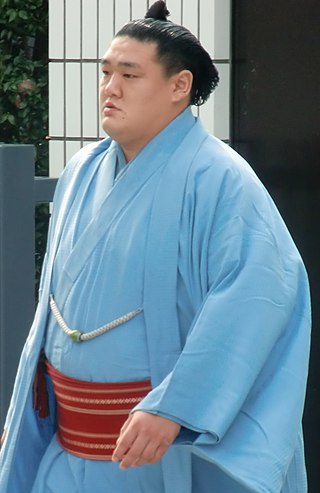
Hōchiyama Kōkan is a former sumo wrestler from Hirosaki, Aomori Prefecture, Japan. He joined professional sumo in 2000. His highest rank was maegashira 14, achieved in 2006. After illness saw him demoted to the third makushita division in 2008, he returned to the second highest jūryō division in 2010 and the top makuuchi division in September 2011. After winning the sandanme division he had just been demoted to in November 2013, he chose to retire. He is now a coach at Sakaigawa stable under the name of Tatsutagawa (立田川).

Kitazakura Hidetoshi, born December 15, 1971, as Hidetoshi Mukō is a former sumo wrestler from Asakita ward, Hiroshima City, Japan. His highest rank was maegashira 9. He is the elder brother of Toyozakura, also a top division wrestler. He was a popular figure with sumo fans. He is now a stable master and elder of the Japan Sumo Association under the name Shikihide-oyakata.

Jūmonji Tomokazu is a former sumo wrestler from Aomori, Japan. Joining the professional ranks in 1992, he reached the top division in 2000 and was ranked there for 34 tournaments until 2007. His highest rank was maegashira 6. He was forced to retire in April 2011 after an investigation by the Japan Sumo Association found him guilty of match-fixing.

Tamarikidō Hideki is a former sumo wrestler born in Edogawa, Tokyo, Japan. Though born in Japan, he is a Zainichi Korean and a member of Mindan. His highest rank was maegashira 8. A former amateur champion, he turned professional in 1997, reaching the top makuuchi division in 2001. He had many injury problems throughout his career, missing over 100 matches, and last fought in makuuchi in 2003. He announced his retirement in January 2010.
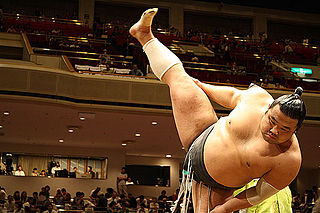
Katayama Shinji is a former sumo wrestler from Yaizu, Shizuoka, Japan. His highest rank was maegashira 13.

Ryūhō Masayoshi is a former sumo wrestler from Nakagami, Okinawa, Japan. His highest rank was maegashira 16.

Towanoyama Yoshimitsu is a former sumo wrestler from Toshima, Tokyo, Japan. He made his professional debut in 1993. His highest rank was maegashira 13, achieved in March 2002. He had many injury problems and had perhaps the unluckiest top makuuchi division career of any wrestler in sumo, being injured before even fighting a match in the division. He is the only wrestler since the beginning of the Shōwa era in 1926 to have been ranked in the top division without winning any bouts there.

Tamaasuka Daisuke is a former sumo wrestler from Atsuta-ku, Nagoya, Aichi Prefecture, Japan. He made his professional debut in March 1998. His highest rank was maegashira 9. He was well known for moving between the top makuuchi division and the second jūryō division on several occasions. He won two makushita and two jūryō division championships. He retired in September 2016 and is now a sumo coach.
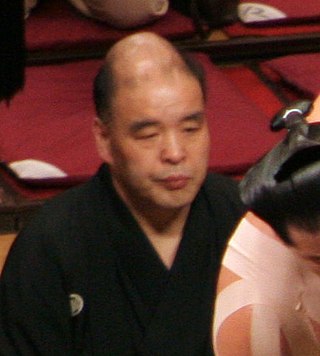
Daiju Hisateru is a former sumo wrestler from Hokkaidō, Japan. His highest rank was ōzeki, but he held the rank for only five tournaments, fewer than any ōzeki in the modern era. He won eleven sanshō or special prizes during his top division career which lasted from 1970 to 1977. He was the head coach of Asahiyama stable from 1997 until 2015.

Shōtenrō Taishi is a former sumo wrestler from Khovd Province, Mongolia. He joined professional sumo in 2001 and was known as Musashiryū Taishi until 2007. He made the top makuuchi division for the first time in 2009 and his highest rank was maegashira 2. He wrestled for Fujishima stable. He acquired Japanese citizenship in 2017 and retired shortly before the January 2018 tournament to become an elder of the Japan Sumo Association. As of June 2022 he is known as Nishikijima Oyakata.
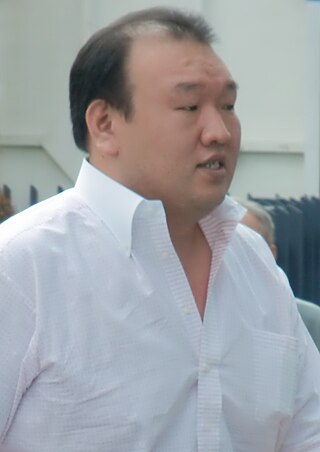
Ganyū Kenji is a former sumo wrestler from Himeji, Hyōgo, Japan. He made his professional debut in March 1986, and reached the top division in March 1996. His highest rank was maegashira 1. He retired in 2000 and became an elder of the Japan Sumo Association. In 2015 he became the head coach of Yamahibiki stable following the death of his old stablemaster, Kitanoumi.
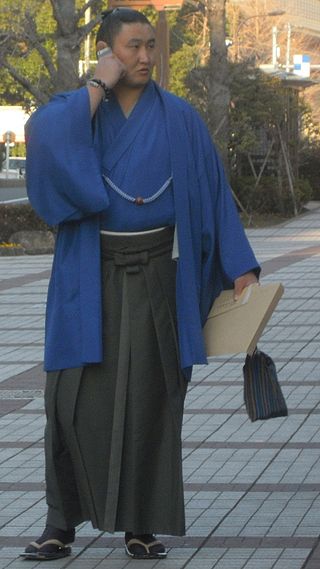
Azumaryū Tsuyoshi is a retired Mongolian professional sumo wrestler from Govi-Altai Province. His highest rank has been maegashira 11. After an amateur sumo career at the Kyushu Institute of Information Sciences, he turned professional in November 2008, reaching sekitori status in January 2013 upon promotion to the jūryō division. He was ranked in the top makuuchi division on nine occasions without earning a winning record before finally achieving it on his tenth attempt in January 2023. He was demoted to the makushita division in 2015, but won promotion back to jūryō in November 2015 and the top division in September 2019. He has one jūryō division championship. He wrestled for Tamanoi stable.
















